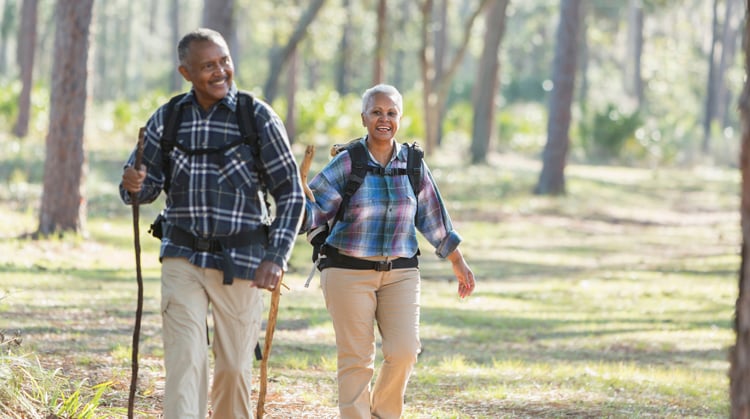June Wellness Spotlight
Healthy Aging for Older Adults
Did you know? Nearly 95% of older adults have at least one chronic disease, and almost 80% have two or more, according to the National Council on Aging in 2022. Aging increases the risk of chronic diseases such as heart disease, type 2 diabetes, arthritis, cancer, and dementia. Fortunately, incorporating healthy behaviors can help older adults live longer, healthier, and happier lives. It’s never too late to start making positive lifestyle changes. The June Wellness Spotlight highlights healthy aging tips for older adults, specifically looking at tips for enhancing physical and emotional wellness as well as developing a care plan for yourself or a loved one.
Physical Wellness
Ensuring physical wellness as an older adult is crucial for several factors. Exercise can help reduce stress and anxiety, improve balance, and lower the risk of falls, improve sleep, and decrease feelings of depression. More importantly, individuals who are physically active are more likely to enjoy more years of life without pain or disability. If older adults do not get enough movement, this can lead to increased visits to the doctor, more hospitalizations, and an increased risk of various chronic diseases. Even after being diagnosed with a chronic disease, physical activity plays an important role in the management of the disease.

Movement & Exercise
- Schedule movement times and activities. Aim for 150 minutes of moderate-intensity exercise and muscle strengthening activities at least 2 times per week.
- Try a variety of activities and see what you enjoy most- walking, lifting weights, gardening, stretching, etc.
- Obtain appropriate clothing and equipment for activities.
- Plan activities with a friend or family member.
- Look into community classes or programs.
Primary Care Provider Visits
For most older adults, it’s recommended to have at least one medical checkup a year. During these visits, it is important to bring up the following:
- Health concerns, changes in behavior, pain, or any other health changes
- Review medications, prescribed AND over the counter medication
- Discuss lifestyle choices
- Review recommended prevention screenings
- Vaccines (view vaccine schedule HERE)
- Cancer screenings (breast, colorectal, prostate, cervical, lung)
- Cholesterol screening
- Diabetes screening
- Blood pressure screening
- Osteoporosis screening (bone density test)
Emotional Wellness
Loneliness & Social Isolation
Loneliness is the feeling of being alone, regardless of the amount of social contact. Social isolation is the lack of social connections. Social isolation can lead to loneliness in some people, while others can feel lonely without being socially isolated. According to the National Academies of Sciences, Engineering, and Medicine, more than 1/3 of adults 45 years and older feel lonely, and 1/4 of adults aged 65 and older are socially isolated (NASEM, 2020). Older adults are at increased risk of being lonely and socially isolated because they are more likely to face factors such as living alone, loss of family or friends, chronic illness, and hearing loss.
Health Risks
- Increased risk of premature death from all causes
- Increased risk of dementia
- Increased risk of heart disease and stroke
- Increased risk of depression, anxiety, and suicide

Staying Connected
The following things are ways to protect yourself or a loved one from the effects of loneliness and social isolation.
- Stay active by joining a walking club or workout with a friend
- Find an activity you enjoy, restart an old hobby, or take a class to learn something new
- Schedule a time each day to stay in touch with family, friends, and neighbors
- Meeting up in person
- Email, call, or text
- Send letters or cards
- If you’re not tech savvy, sign up for a class at the local library or community center to help you learn how to use email or social media
- Consider adopting a pet if you are able to take care of them
- Find a faith-based organization to deepen your spirituality and connect with others that share similar beliefs
- Check out resources and programs in your local service agencies (community centers, senior centers, or public libraries)
- Volunteer or get involved in the community
Creating a Care Plan
It’s essential to keep all your important information in one place. A care plan summarizes an individual’s health conditions, specific care needs, and current treatments. The care plan can help organize and prioritize caregiving activities along with ensuring the care recipient’s needs are being met.
Benefits
- Reduce emergency room visits and hospitalizations
- Improve overall medical management for people with chronic health conditions (like Alzheimer’s disease)
- Helps retain quality of life and independence for the care recipient
Develop a Care Plan
- Personal information (name, date of birth, contact information)
- Health conditions
- Medication with dosages and when/how given
- Health care providers with contact information
- Health insurance information
- Emergency contacts
COMPLETE CARE PLAN EXAMPLE: https://www.cdc.gov/aging/caregiving/pdf/Complete-Care-Plan-Form-508.pdf
References
- Centers for Disease Control and Prevention. (2022, October 27). Supporting family caregivers. U.S. Department of Health and Human Services. https://www.cdc.gov/aging/publications/features/caregivers-month.html
- Centers for Disease Control and Prevention. (2021, September 15). Healthy aging. U.S. Department of Health and Human Services. https://www.cdc.gov/aging/olderadultsandhealthyaging/index.html
- Centers for Disease Control and Prevention. (2021, December 14). Loneliness and social isolation linked to serious health conditions. U.S. Department of Health and Human Services. https://www.cdc.gov/aging/publications/features/lonely-older-adults.html
- Centers for Disease Control and Prevention. (2023, February 9). Adult immunization schedule by vaccine and age group. U.S. Department of Health and Human Services. https://www.cdc.gov/vaccines/schedules/hcp/imz/adult.html
- National Academies of Sciences, Engineering, and Medicine. (2020). Social isolation and loneliness in older adults: Opportunities for the health care system. The National Academies Press. https://nap.nationalacademies.org/catalog/25663/social-isolation-and-loneliness-in-older-adults-opportunities-for-the
- National Council on Aging. (2022, December 12). Get the facts on healthy aging. https://www.ncoa.org/article/get-the-facts-on-healthy-aging
- National Institute on Aging. (n.d.). Healthy aging tips for the older adults in your life. U.S. Department of Health and Human Services. https://www.nia.nih.gov/health/caregiving/healthy-aging-tips-older-adults-your-life
- National Institute on Aging. (2021, January). Understanding loneliness and social isolation: How to stay connected. U.S. Department of Health and Human Services. https://order.nia.nih.gov/sites/default/files/2021-01/understand-loneliness-and-social-isolation.pdf


